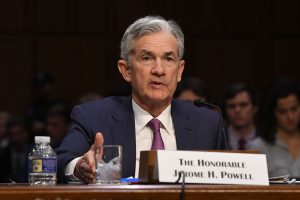 A focus on transparency and ensuring that the policy actions by the Federal Reserve [1] to support the goals of maximum employment and price stability were the theme of Fed Chair Jerome Powell's semi-annual monetary report [2] to the Congress on Tuesday. The Senate Banking Committee [3] held the semi-annual testimony.
A focus on transparency and ensuring that the policy actions by the Federal Reserve [1] to support the goals of maximum employment and price stability were the theme of Fed Chair Jerome Powell's semi-annual monetary report [2] to the Congress on Tuesday. The Senate Banking Committee [3] held the semi-annual testimony.
In his opening remarks Sen. Mike Crapo, Chair of the Banking Committee said that this hearing provided the committee an opportunity to examine the current state of the U.S. economy, the Fed's implementation of monetary policy, and its supervisory and regulatory activities.
"I appreciate the work the Fed has done so far to introduce proposals and finalize rules required by the law. Overseeing the full implementation of that law and the federal banking agencies’ rules to right-size regulations will continue to be a top priority of the Committee this Congress," Crapo said.
Giving an overview of the economy, Powell said that in 2018, economic growth was supported by "increases in employment and wages, optimism among households and businesses, and fiscal policy actions." However, he indicated that over the past few months "some of the data have softened but still point to spending gains this quarter."
"While the partial government shutdown created significant hardship for government workers and many others, the negative effects on the economy are expected to be fairly modest and to largely unwind over the next several months," Powell said.
Despite the rising wages and jobs in the country, Powell said that disparities still persisted across various groups of workers and different parts of the country. "For example, unemployment rates for African Americans and Hispanics are still well above the jobless rates for whites and Asians," he said.
The housing market last year had also shown declining activity amid rising mortgage rates and higher material labor costs, the monetary report by the Fed indicated.
Looking at the current economic conditions, Powell said that the Fed had seen "some crosscurrents and conflicting signals."
"Financial markets became more volatile toward year-end, and financial conditions are now less supportive of growth than they were earlier last year," he said.
Speaking about the monetary policy and the Fed's approach to it, Powell said that since July 2018, "the expected path of the federal funds rate over the next several years shifted down, long-term Treasury yields and mortgage rates moved lower, broad measures of U.S. equity prices increased somewhat, and spreads of yields on corporate bonds over those on comparable-maturity Treasury securities widened modestly."
"We have also continued to gradually shrink the size of our balance sheet by reducing our holdings of Treasury and agency securities," he said.
According to the report, the Federal Reserve's total assets declined about $310 billion since mid-2018 and currently stand at approximately $4 trillion. Relative to their peak level in 2014, banks' reserve balances with the Federal Reserve have declined by around $1.2 trillion, a drop of more than 40 percent.
"In the longer run, the size of the balance sheet will be determined by the demand for Federal Reserve liabilities such as currency and bank reserves," Powell said in his testimony.
Click here [4] to watch the Fed Chair's full semi-annual monetary policy report to the Congress.